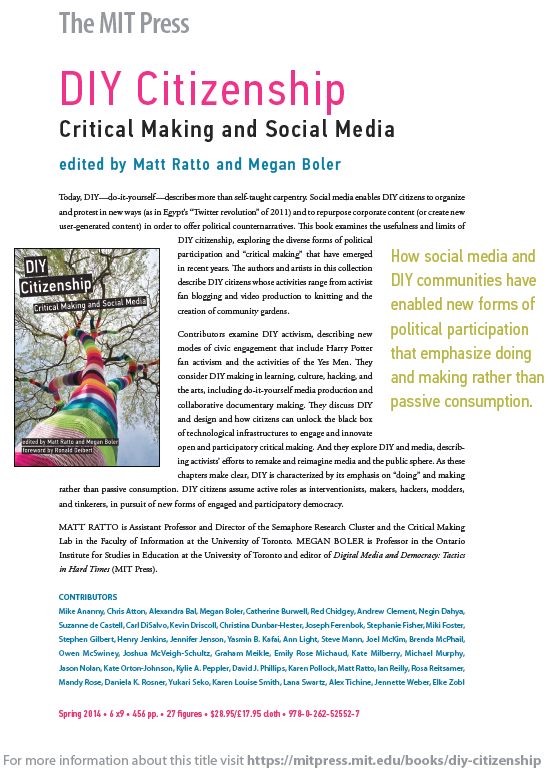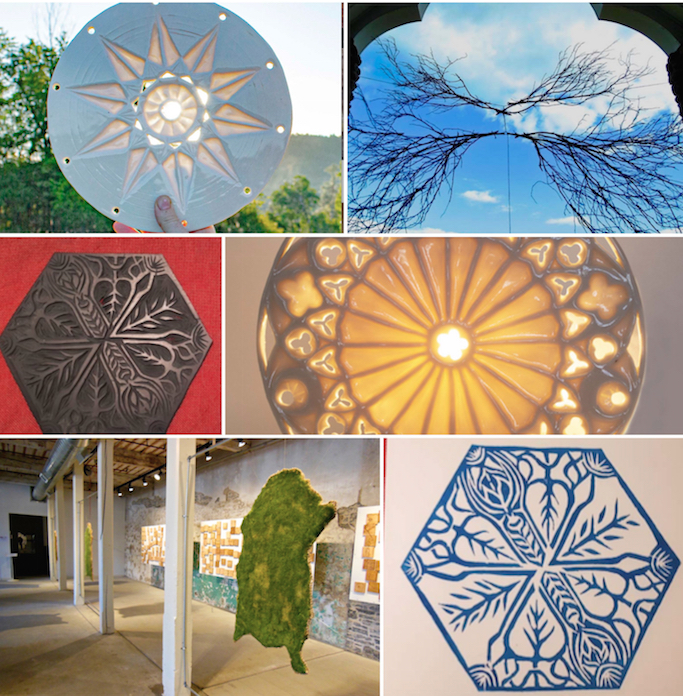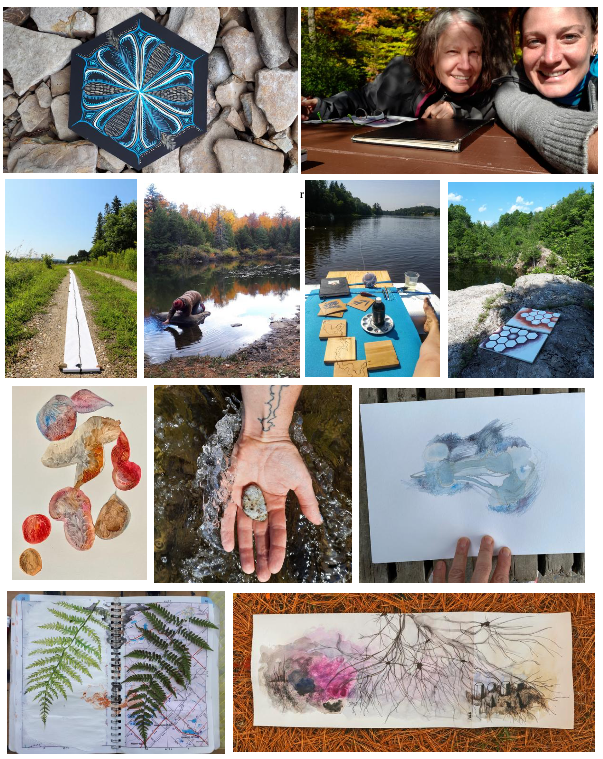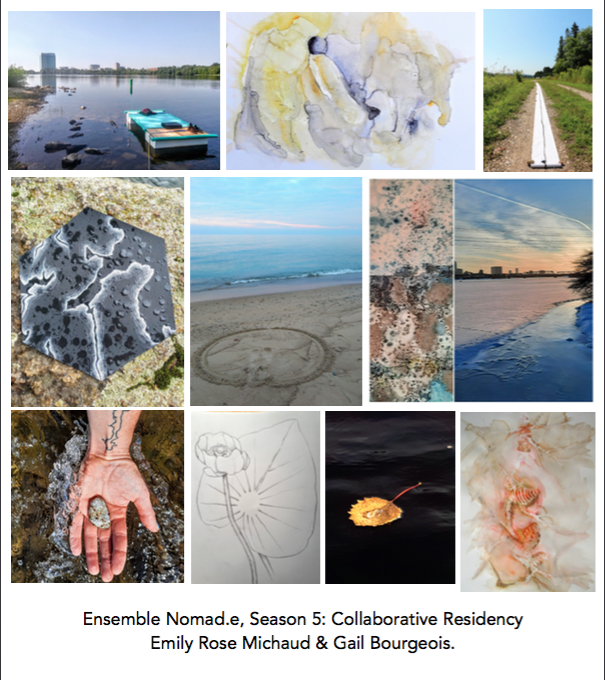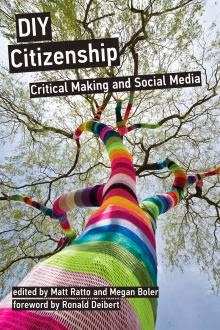
NEW BOOK RELEASE: DIY CITIZENSHIP: Critical making and Social Media, MIT Press, 2014.
After many long years in the making, THE BOOK, is finally out! Published by MIT press no less. DIY Citizenship: Critical Making and Social Media includes an essay I co-wrote with architect Owen McSwiney, in which we discuss the work of the Montreal based non-profit group Les Amis du Champ des Possibles (Field of Possibilities) who managed to preserve an urban green space as a community park (an Urban Biodiversity Reserve is currently in the works). The humble beginnings go back to a Land Art project I initiated in 2007, entitled the Roerich Garden, made to draw attention to the need to protect the land from development. A passage of the essay can be found at the bottom of this post.
“How social media and DIY communities have enabled new forms of political participation that emphasize doing and making rather than passive consumption” From an excerpt by the editors Megan Boler and Matt Ratto.
NEW BOOK RELEASE: DIY CITIZENSHIP: Critical making and Social Media, MIT
Press, 2014, eds Matt Ratto and Megan Boler (University of Toronto).
Today, DIY ‹do-it-yourself‹ describes more than self-taught carpentry. Social media enables DIY citizens to organize and protest in new ways (as
in Egypt¹s ³Twitter revolution² of 2011) and to repurpose corporate content (or create new user-generated content) in order to offer political counternarratives. This book examines the usefulness and limits of DIY citizenship, exploring the diverse forms of political participation and ³critical making² that have emerged in recent years. The authors and artists in this collection describe DIY citizens whose activities range from activist fan blogging and video production to knitting and the creation of community gardens.
Contributors examine DIY activism, describing new modes of civic engagement that include Harry Potter fan activism and the activities of the Yes Men. They consider DIY making in learning, culture, hacking, and the arts, including do-it-yourself media production and collaborative documentary making. They discuss DIY and design and how citizens can unlock the black box of technological infrastructures to engage and innovate open and participatory critical making. And they explore DIY and media, describing activists¹ efforts to remake and reimagine media and the public sphere. As these chapters make clear, DIY is characterized by its emphasis on ³doing² and making rather than passive consumption. DIY citizens assume active roles as interventionists, makers, hackers, modders, and tinkerers, in pursuit of new forms of engaged and participatory democracy.
MATT RATTO is Assistant Professor and Director of the Semaphore Research Cluster and the Critical Making Lab in the Faculty of Information at the University of Toronto. MEGAN BOLER is Professor in the Ontario Institute for Studies in Education at the University of Toronto and editor of Digital Media and Democracy: Tactics in Hard Times (MIT Press).
CONTRIBUTORS
Mike Ananny, Chris Atton, Alexandra Bal, Megan Boler, Catherine Burwell, Red Chidgey, Andrew Clement, Negin Dahya, Suzanne de Castell, Carl DiSalvo, Kevin Driscoll, Christina Dunbar-Hester, Joseph Ferenbok, Stephanie Fisher, Miki Foster, Stephen Gilbert, Henry Jenkins, Jennifer Jenson, Yasmin B. Kafai, Ann Light, Steve Mann, Joel McKim, Brenda McPhail, Owen McSwiney, Joshua McVeigh-Schultz, Graham Meikle, Emily Rose Michaud, Kate Milberry, Michael Murphy, Jason Nolan, Kate Orton-Johnson, Kylie A. Peppler, David J. Phillips, Karen Pollock, Matt Ratto, Ian Reilly, Rosa Reitsamer, Mandy Rose, Daniela K. Rosner, Yukari Seko, Karen Louise Smith, Lana Swartz, Alex Tichine, Jennette Weber, Elke Zobl
For more information about this title visit: https://mitpress.mit.edu/books/diy-citizenship
* A passage from the essay, by Emily Rose Michaud and Owen McSwiney, December 2012.
artists have intervened to create integrated site-specific works in
the open-air studio and informal exhibition space that is the field.
Some of the first documented
actions which engaged with the field creatively and documented the
reclamation of a public space in the face of looming development
included the Roerich Garden
Project and the
Sprout Out Loud Guerilla Gardener’s Ensemble. P.sdfootnote { margin-left: 0.5cm; text-indent: -0.5cm; margin-bottom: 0cm; font-size: 10pt; }P { margin-bottom: 0.21cm; }A:link { }A.sdfootnoteanc { font-size:
The
Roerich Garden
was created in 2007 as a living landmark to pay homage to the
threatened green space. It drew attention to the city’s plans and
provoked dialogue about the many ways the community used and
interacted with the space. It provided a forum to gather and to
valorize the space before it was forgotten in silence. The Roerich
Symbol is the cultural equivalent of the Red Cross. Its’ three
circles are said to represent art, science and religion. Russian
artist and cultural activist Nicholas Roerich developed it as an
internationally recognized symbol to protect historical, cultural,
and scientifically valuable monuments. Intended to prevent aerial
bombing in WWII Europe, it was installed on rooftops of museums,
churches and universities.
The
gardeners’ ensemble Sprout Out
Loud occupied the southern
section of the field from 2008 until 2010. Through their
collaborative seed exchanges, planting sessions, and maintenance of
the Roerich Garden,
they explored concepts of public space and
sought to encourage the
relationship between urban dwellers and the land around them. Their
goals included: i-stimulating citizen engagement and provoking
dialogue regarding the importance of the commons through workshops
and community events; ii- engaging with the field to document how
people used and cared for the space; iii- empowering people and
inviting them to plant similar ideas in their own environments where
needed.
In
2008, an initiative to document the Roerich
Garden Project was launched in
collaboration with Artefatica1,
a local open publishing project. Over the span of three years,
members of Les Amis
and Artefatica collected stories from more than 40 contributors about
the space’s history, uses and potential. The result — an online
book at roerichproject.artefati.ca
— brings together texts, photos, news clippings, and archival
materials, as well as examples of similar international precedents.”

